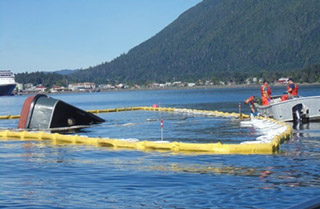As Royal Dutch Shell explores for oil in the Chukchi Sea, the Coast Guard has come up with what it foresees as the worst-case scenarios, if indeed Shell’s venture leads to a wider opening of Arctic energy resources.
In a paper prepared for a multinational Arctic Council working group on disaster preparedness, Coast Guard planners outlined two contingencies that would require a massive control and cleanup response – with limited success in the harsh environment of the high latitudes.
Drawing on documents prepared over years of work by the Alaska Department of Environmental Conservation, the Coast Guard looked at the potential for a single exploratory well accident that defeats blowout preventer safeguards, venting 61,000 bbls. a day for starters before being brought under control in 74 days after a 2 million-bbl. spill.
That would be about half the volume of the 2010 Deepwater Horizon disaster in the Gulf of Mexico, where estimates say 4.2 million to 5 million bbls. vented over 86 days. But in the Arctic, sea conditions would be far worse.
“Winter is fast approaching. The ice edge has already passed the platform and is continuing to advance rapidly,” the scenario paper states. “Ice coverage exceeds 60% at the time of the spill. Estimates indicate ice coverage will exceed 75% in 30 days and approach 100% within 60 days of the initial spill date.”
There are resources in place on Alaska’s North Slope to start a cleanup – the region has lots of booming and skimming equipment to retrieve floating oil, the paper notes. But time is limited and by early November those operations would be limited by crew safety considerations.
A scenario with potentially international implications would be a tanker spill in the Aleutian Islands, with long-term impact on remote island settlements and wildlife.
That exercise imagines an Asia-bound tanker that attempts to divert to Dutch Harbor after a partial power failure, only to collide with a fish processing vessel in the confines of the Unimak Pass. The tanker limps into Dutch Harbor, but not before losing 200,000 bbls. of a heavy petroleum product called vacuum tower bottom blend (VTBB).
Even in April, with sea states of 10’ to 30’ and temperatures around 40 degrees, regional spill response cooperatives would have their work cut out for them. Oil would be cast up on rocky shores close to the accident scene, and farther out to sand and gravel shorelines, wave-cut terraces and tidal flats.
“Resources in the immediate area of the spill that are at risk include sea lions, otters, waterfowl concentrations, and seabird colonies,” the paper notes. “Unimak Pass is a major transportation route for vessels transiting the Great Circle Route between North America and the Far East. Any significant spill in this area would severely impact international trade as well as local and regional users of this location.”
On the plus side, Alaska has “a ready fleet of response vessels experienced in pollution operations … located in Kodiak, English Bay, Port Graham, Homer, Kenai, and Seldovia,” and many commercial and fishing vessels that could be recruited to the response, according to the paper. “An available armada of response vessels exists with great potential to benefit a spill response if properly supported and managed effectively.”
But the logistics would be daunting, with the need to house and feed cleanup crews over a huge expanse.
The scenarios will figure in a three-day exercise this month hosted by Coast Guard officials with representatives of the Arctic Council. “We wanted something that was realistic, based on real-world activity and real-world activity has inherent risks,” Mark Everett, a Coast Guard incident management, told the Alaska Dispatch News.




